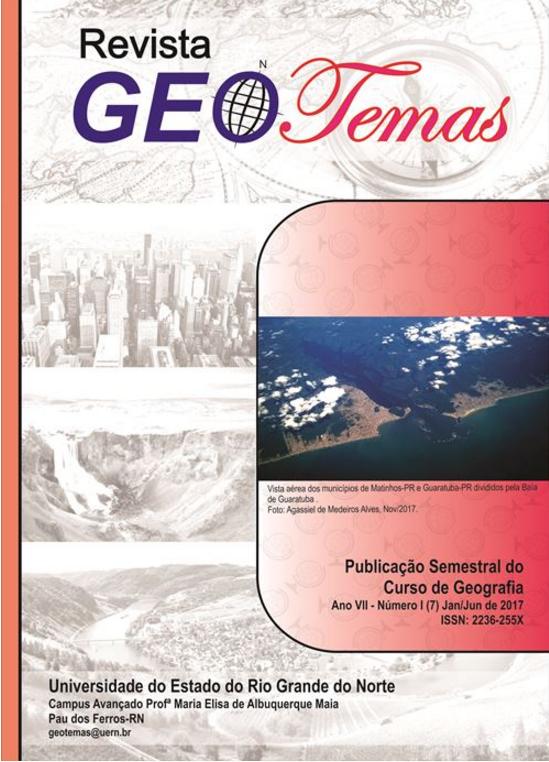ESTIMATING ERODIBILITY FACTOR (K) OF ASSOCIATIONS OF SOILS IN PIAUÍ
Keywords:
Soil Erodibility (K), conservation planning of land use, soil erosion by waterAbstract
The soil erodibility (K) is the term of the Soil Loss Universal Equation, expressing vulnerability or susceptibility of soil to erosion. Considering the importance of this factor in triggering the erosion process, the present study aimed to estimate the values of soil erodibility for the soil associations in the state of Piaui. The method used to estimate the values of soil erodibility was the Römkens et al. (1987, 1997). The results indicate the largest value of K ton.ha.h / MJ.mm.ha for association PE5 of about 0,063 and the lowest value was 0, 010 for associations AM and R22. The variation observed in the values of K occurs both between different groups of soil associations, but also within a group of associations. 0.7%, 43.9%, 50.6%, 4.2%, and 0.3% of the area respectively show values of erodibility in the low, medium, high, very high and extremely high classes. There is a predominance of K values located in the middle and upper classes, for a total of 94.4% of the state area. This finding requires attention concerning the different uses undertaken in the state, especially in the southeastern portion of the state characterized by semi-arid climate, savanna vegetation and rudimentary practices land use, which can accelerate the erosion of soils, which in turns, can lead to a desertification process and consequent impairment of the populations quality of life.
Downloads
References
AMORIM, R. S.S.; SILVA, D. D.; PRUSKY, F.F.; MATOS, A.T. Avaliação do desempenho dos modelo de predição da erosão hídrica USLE, RUSLE e WEPP para diferentes condições edafoclimáticas do Brasil. In: Engenharia Agrícola, vol. 30, n. 6, p.1046-1049, 2010.
BERTONI, J. & F. LOMBARDI NETO. Conservação do Solo. São Paulo, ícone ed., 1999.
CEPRO. Diagnóstico das condições ambientais do estado do Piauí. Teresina: Fundação Cepro, 1996.
CEPRO. Piauí: Caracterização do Quadro Natural – Teresina: Fundação Cepro, 1996.
EL-SWAIFY, S.A.; E.W. DANGLER & C.L.ARMSTRONG, Soil erosion by water in the tropics. Honolulu: Research extension service nº 024, University of Hawaii. 1982.
HOLANDA NETO. M.R.; SALVIANO, A.A.C.; ARAÚJO, F.S. ARAÚJO. Estimativa da Erodibilidade de Latossolos do Piauí. In: Scientia Plena, vol. 7, n. 10, 2011.
HUDSON, N. Soil conservation. Iowa State University Press. Iowa, 1981.
JACOMINE, P.K.T. - Levantamento exploratório-reconhecimento de solos do estado do Piauí. Recife: DPP, AgMA/DNPEA, SUDENE/DRN, 1986. (Boletim de pesquisa nº 26).
JACOMINE, P.K.T. Levantamento exploratório-reconhecimento de solos do estado do Piauí. Recife: DPP, AgMA/DNPEA, SUDENE/DRN, 1986. (Boletim Técnico nº 28).
LAL, R. & W. ELLIOT. Erodibility and erosivity. In: LAL,R. Soil Erosion: research methods. p.180–208., Ankeny: Soil and Water Conservation Society, 1994.
LEPRUN, J. C. Manejo e conservação de solos no Nordeste. Recife: SUDENE, 1988.
MANNIGEL, A.R.; CARVALHO, M.P.; MORETI, D.; MEDEIROS, L.R. Fator erodibilidade e tolerância de perda dos solos do Estado de São Paulo. In: Acta Scientiarum, Maringá, V. 24, n. 5, p. 1335-1340, 2002.
MARQUES, J. J. G. de S. M. Estimativas e comparações dos fatores erosividade das chuvas e erodibilidade de solos com horizonte B textural no Brasil. Dissertação de Mestrado, Departamento de Solos, Universidade Federal de Lavras, Lavras, 1996.
PISSARA, T.C.T.; ARRAES, C. L.; BUENO, C.R.P. Estimativa da erodibilidade do solo para fins conservacionistas na microbacia Córrego do Tijuco, SP. In: Biosci. Journal., Uberlândia, v. 26, n.6, p. 849-857, Nov/Dec.2010.
RENARD, K.G.; L. D. MEYER & G.R. FORSTER. Introduction and history. In: RENARD, K.G., G.R. FORSTER, G.A WEESIES, D. K. McCOOL & D.C. YODER (Coordinators) –Predicting Soil Erosion by Water: A Guide to Conservation, Planning with the Revised Universal Soil Loss Equation (RUSLE) p 2 – 18, Washington: USDA/ARS, Agriculture Handbook nº 703, 1997.
ROMKENS, M. J.M., R.A. YOUNG, J.W. A POESEN, D.C. McCOOL, S.A.EL-SWAIFY e J.M. BRADFORD – Soil Erodibility Factor (K). In: RENARD, K.G., G.R. FODSTER, G.A WEESIES, D. K. McCOOL & D.C. YODER (Coordinators), Predicting Soil Erosion by Water: A Guide to Conservation, Planning with the Revised Universal Soil Loss Equation (RUSLE). p 65 – 100, Washington: USDA/ARS, Agriculture Handbook nº 703, 1997.
ROMKENS, M. J.M., S. N. PRASAD & J.W. A POESEN. Soil Erodibility na Properties. In: Anals of the VIII CONGRESS of the ISSS, p. 492 – 503, Hamburg 1987.
RUTHES, J. M.; TOMAZONI, J.C.; GUIMARíES, E.; GOMES, T.C. Propriedades do solo da bacia hidrográfica do rio Catorze que intensificam a erosão laminar. In: Revista Brasileira de Geografia Física, Recife, v. 01, n.1, p. 160-169, 2012.
SEMAR, Panorama da Desertificação no Estado do Piauí - Relatório de Consultoria. Teresina, 2005.
SHIRAZI, M. A. & BOERSMA, L. A. A unifying quantitative analyses of soil texture. Soil Science Society of America Proceedings, Las Vegas, 48(1):142 – 147, 1984.
SILVA, J.R.C. Erodibilidade dos solos do Ceará: distribuição espacial e avaliação de métodos para sua determinação. Tese para concurso de professor titular, Departamento de Solos, Universidade Federal do Ceará, Fortaleza, 1994b.
Downloads
Published
How to Cite
Issue
Section
License
Authors who submit their manuscripts to Geotemas declare that the work is an original article and has not been submitted for publication, in full or in part, in another national or international scientific journal or in another circulation vehicle. The authors also declare that they agree with the transfer of the copyright of the referred article to the magazine Geotemas (University of the State of Rio Grande do Norte), allowing for later publications, as long as the source of its publication is assured. Finally, they assume public responsibility for the article, being aware that any charges arising from a claim by third parties regarding the authorship of the work may apply to them.



















